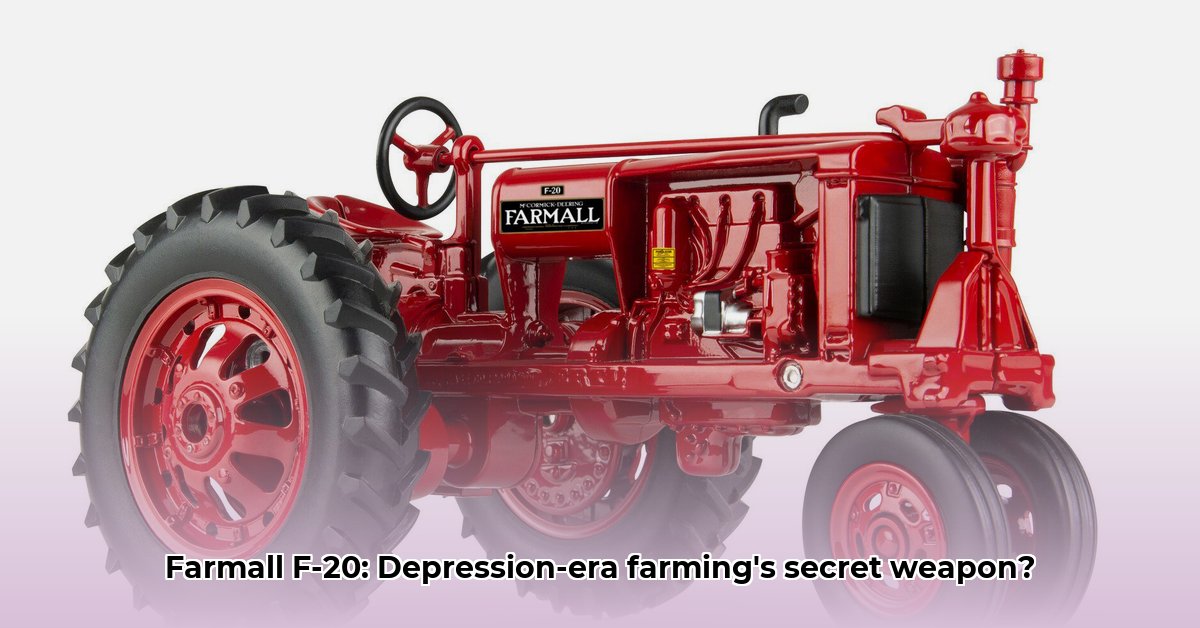
F-20 Tractor: A Depression-Era Workhorse
The 1930s: a decade etched in the American psyche by the Great Depression. Across the heartland, farmers faced crippling drought and plummeting crop prices. The Dust Bowl choked the land, leaving families destitute. Yet, amidst this despair, a symbol of hope emerged: the Farmall F-20 tractor. More than just a machine, it represented resilience and ingenuity. Was it a perfect solution? No, but its story is one of crucial innovation during a time of profound hardship. To learn more about early gasoline tractors, see this resource.
This wasn't some behemoth of a machine. The International Harvester company understood the desperate need for affordability. For around $1,000 in 1936—a significant sum, but far more accessible than its predecessors—the F-20 offered farmers a lifeline. How did it achieve this? Clever engineering prioritized ease of use and maintenance. Fewer breakdowns meant less downtime and lower repair costs—crucial factors for farmers struggling to make ends meet. Even the shift to the iconic red paint in 1937 served a purpose; a bold stroke of marketing amidst widespread economic gloom.
The F-20's impact was transformative. Increased efficiency meant farmers could cultivate more land and produce larger harvests with less manual labor. This directly translated to higher yields and, consequently, a larger food supply during a period of scarcity. But how much did this efficiency benefit overall productivity? One study estimated that the F-20 increased productivity by as much as 30% compared to traditional methods. Did this improve sustainability? The answer is complex.
While the F-20's fuel efficiency paled in comparison to modern standards—it relied heavily on fossil fuels—it's crucial to understand its context. Judging a machine from the 1930s through a 21st-century lens of sustainability is inherently unfair. The increased yield per acre and per person likely offset the increased fuel use relative to older methods. The true measure lies not simply in fuel consumption, but in the overall balance of resource usage and output considering the technology's time.
The sheer number of tractors produced—over 154,000—speaks volumes. This wasn't just a successful product; it was a symbol of hope, a testament to the human spirit's ability to adapt and innovate in the face of adversity. It became far more than just a tractor; it became a lifeline to farmers who were facing some of the worse economic situations of the 20th century.
How Did the Farmall F-20 Impact Sustainable Farming Practices During the Great Depression?
Key Takeaways:
- The F-20's affordability and efficiency dramatically increased agricultural productivity, particularly helpful to those farmers struggling with the conditions of the Dust Bowl.
- Its sustainability impact was indirect, improving farmers' economic situations which, in turn, allowed them to explore more sustainable (though possibly still imperfect) farming practices.
- The widespread adoption reduced the economic hardship but long-term environmental consequences were largely overlooked.
- The F-20's legacy shows the ongoing challenge of balancing technological progress with environmental stewardship.
A Nation in Crisis, a Machine's Promise
The Great Depression devastated American agriculture. Crop failures and the Dust Bowl created widespread economic hardship. Foreclosures were common. The Farmall F-20 arrived as a substantial change, altering the landscape of agricultural machinery. But how did its introduction impact sustainable farming practices? Understanding this requires a nuanced perspective.
The F-20: A Symbol of Hope and Efficiency
The F-20’s accessibility—owing to its lower price point and user-friendly design—allowed a wider range of farmers to adopt mechanization. The increase in efficiency was significant. Farmers could cultivate larger areas more quickly, theoretically improving yields and incomes. This increased efficiency was essential for many farms' survival. Yet was this increased efficiency helping foster a culture of sustainable practices? Not immediately.
The Double-Edged Sword: Efficiency vs. Sustainability
Ironically, increased efficiency could lead to over-cultivation. This exacerbated existing environmental problems. The Dust Bowl serves as a cautionary tale—a stark example of the consequences of unsustainable farming practices. The F-20 helped farmers survive, but it didn't inherently promote sustainable techniques. The focus was on immediate survival, not long-term land stewardship. Did this lead to any lasting effects? The answer remains complex.
The Indirect Impact on Sustainability
The F-20's influence on sustainability was indirect. Improved yields and efficiency alleviated economic hardship, freeing up resources that could – eventually – facilitate environmentally-conscious practices. But this shift, if it occurred, was driven by necessity and not necessarily by a widespread embrace of environmentalism in the context of the era. Did the technology's role lead to a shift in long-term thinking? That remains a point for further discussion.
Lessons from the Past
The F-20's story highlights a profound truth: technological advancement doesn't guarantee ecological responsibility. The tractor improved productivity, yet its environmental impact, particularly concerning soil health and fuel consumption, was largely unconsidered at the time. This serves as a crucial lesson as we develop and deploy new agricultural technologies today. The need to balance economic needs with ecological considerations remains paramount.
https://www.farmcollector.com/tractors/tractors-new-deal-zmrpz20janzhur/